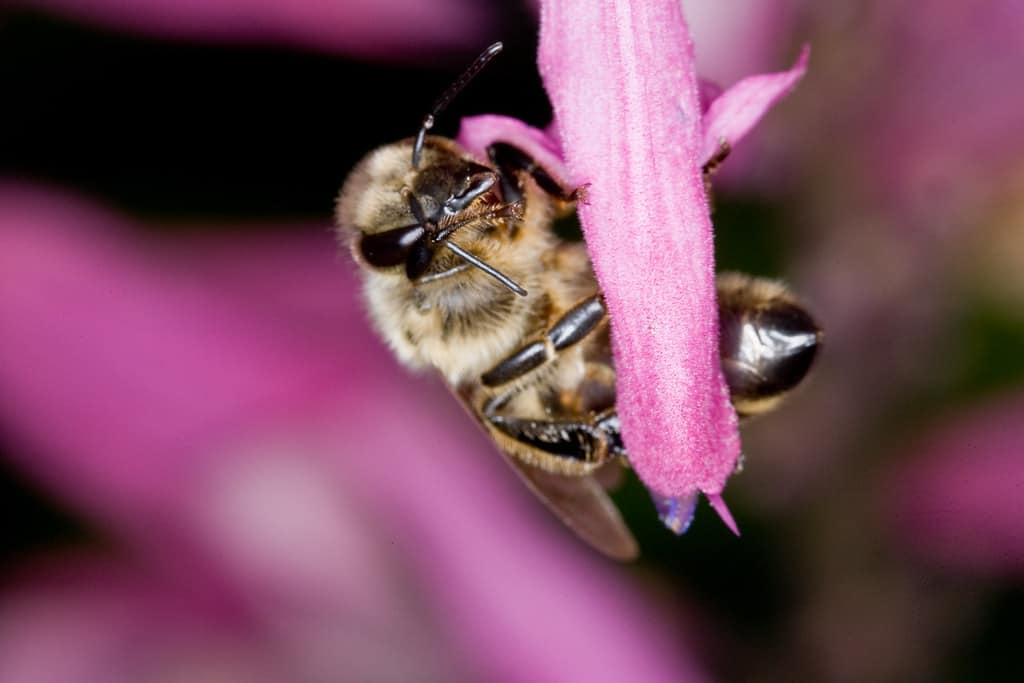Dark hair
The products of a honey bee hive are all entirely edible; the bees, the honey, the larvae, the wax, and so on. For a hungry bear or skunk, this is an opportunity for a feast of delightful sugar and protein, especially in the autumn when food begins to get scarcer and the animals are hunkering down for a long winter’s nap. At this time, the hive is full of honey and pollen for the colony’s own winter stores.
Although attacks from bears and skunks can occur at any time of the year, the colony is most susceptible in the fall since they won’t be able to recover the hive in time for winter. Identifying the hungry beasts before they invade is crucial to buy the bees enough time to build a defense, and one of the main identifiers is the dark fur of these mammals.
Dark colors in general cause bees to become wary, as dark masses moving in their vision can only spell trouble. Dark hair colors can trigger a warning in bees, and may result in some defensive workers coming at your hair! Luckily, an easy solution is to cover up with a light-colored hat.

Bananas
Honey bees communicate through several methods, but one of the most effective is the use of chemical signals called pheromones. The pheromones produced by the queen bee are powerful enough to inhibit the ovaries of worker bees, preventing them from laying eggs.
Several different chemical signals are used to convey different messages to the rest of the hive, one of which is an alarm signal. When a worker feels threatened or even stings someone, a defense pheromone is released to inform nearby bees of the danger. They will then release the same signal, passing the message quickly through the colony.
So… why bananas? Technically, bees don’t hate the smell of bananas but rather it triggers a defense response because both the sting alarm pheromone and bananas contain isomyl acetate. This compound lends bananas their unique scent, making them strong enough to illicit a response from the bees.
Strong scents
Imagine being with a group of people and trying to have an important conversation. Suddenly, a loud noise interrupts and none of you can hear one another. Annoyingly, you are forced to continue your meeting in another location in order to hear properly.
Bees don’t hear very well; they can pick up on vibrations in the air but their ability to fine-tune these vibrations isn’t particularly good. Pheromones allow bees to talk through scents, so just like a meeting being drowned out by loud noises, strong scents inhibit the bees’ senses and they have a harder time getting messages across through their pheromones. Essential oils with strong smells like lavender, citrus, and peppermint can drive bees away from the area.
Wormwood
Some plants are popular for their ability to drive away unwanted insects, such as how marigolds are known to deter mosquitoes. Plants often don’t produce scents to repel bees; they need them to pollinate their flowers! Wormwood has historically been used to flavor absinthe, but it contains a toxic chemical called thujone that resulted in the banning of “true” absinthe from Europe and the US. Despite this, absinthe is still legal in many other places, including Canada. The toxic substances found in wormwood deter bees and wasps. Luckily for the plant, most species in the Artemisia genus are wind-pollinated, so they don’t need to attract insects to their flowers.

CO2
A black bear coming up to a hive is bad news for the bees. They’ll see the large black hairy shape, release their banana-scented pheromones, and alarm the colony to be on the defense. However, bears are large creatures with thick fur and they can certainly sustain a few stings in exchange for a full meal.
The ability for bees to detect scents gives them an advantage; not only can they smell sweat coming off a mammal, they can identify CO2, and it triggers defense. This might not seem too important, but the face is a very vulnerable and sensitive area to receive stings, and given that we breathe out carbon dioxide, bees can immediately use that to determine where a person or animal’s face is. A wave of CO2 over some bees can trigger an alarm response, as they may think a threat is looming overhead.
